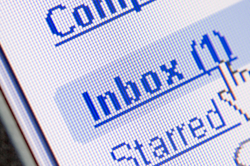Finish Line's Mobile Checkout System: Practical vs. Potential
By November, the 654-store Finish Line sportswear chain will become the first major retailer to have mobile checkout in every one of its stores, just in time for the holidays. But while piloting the system in almost 50 stores, the $1.4 billion Indianapolis chain has had to wrestle with the practical versus the potential.

Image courtesy of FinishLine.com
For example, the associate-issued mobile units have full CRM access, so associates are able to review a customer's full purchase history to deliver the best experience. To avoid awkwardness, though, most associates don't access such history until after a sale is completed, when asking for a loyalty card seems natural.
"It undermines the strategy," said Finish Line CIO Terry Ledbetter. "But quite frankly, it was hard to imagine how resistant customers would be to telling you who they are. 'You don't need to know who I am,'" he said, adding that the chain is exploring using an opt-in feature on its mobile app that would broadcast to all associates when a customer walks in the store.
Finish Line's mobile IT effort goes far beyond the 1,600 countertop — and 3,200 iPod Touch card-acceptance — devices from VeriFone, plus the large number of tablets for customers to use to check inventory and compare products. It needed upgraded Micros POS systems, increased network throughput for associates (no customer Wi-Fi yet) and upgrades for Oracle databases and Manhattan Associates supply chain systems.
"It's a full mobility play," Ledbetter said, pointing to his chain's new ability to handle EMV/Chip-and-PIN, contactless, NFC and Bluetooth 4.0 payments.
As another example of the practical, Ledbetter has been watching the many mobile wallet trials but not participating yet. The system in place for November is simply swiping magstripe cards through a sled on one of the mobile units — not dissimilar to how Apple Stores do it. (Though, hopefully, skipping the part where Apple arrests customers who forget to click a button in its payment app.)
"Our reality right now is that mobile wallets and mobile payments are fledgling," Ledbetter said. "Obviously, you know something is coming, but there are so many different groups trying to figure out how to get this thing to a critical mass. My opinion is that some form of mobile settlement is going to come to the United States. There's a lot of money on the table, but the biggest thing getting in the way is ourselves," meaning the retailers and all the payment players. But until one or two of the efforts achieves substantial market share, Finish Line is going to watch and not jump in.
One key difference with Finish Line's approach to mobile checkout is its focus on associate training, something that other chain's trials have minimized. "The buck starts and stops with the associates. We're training associates on how to use the technology in a meaningful way" using "role-based training," Ledbetter said.
For example, when does the associate offer to check out a customer using the mobile device as opposed to having them use the traditional cash wrap? It's simply a matter of looking at the length of the line and determining which would be better for the customer. "We have to look at these as a retailer in a very different way. It's a lot more than a small POS. How do you use the technology to benefit the customer?"
To make it work, the chain has placed remote printers throughout the store (for hard-copy receipts) and filled various drawers with bags. As is typical, receipts will be offered as electronic copies sent through E-mail or as paper handed to the customer after checkout is complete.

Ledbetter said he had initially expected almost all customers to opt for the E-mailed receipts, but that didn't happen. "You would think that getting a receipt E-mailed would be the best thing since sliced bread," he said, adding that fears of this new system are making customers comfortable with the older approach, at least in the beginning. But he's already seeing a shift since the trials began some 60 days ago. "The amount of printed receipts is already dropping sharply," he said.
The national rollout (the chain runs 635 Finish Line stores in every U.S. state except Alaska and Hawaii, plus 19 Running Company stores) is critical for the holidays. To play it safe, Ledbetter is rolling out the stores from highest contribution (revenue) to lowest. This way, if anything glitches, the greatest amount of revenue is covered, he said.
The pilot process was also done carefully, with an initial plan to test in 32 "cross-class stores," meaning that the test stores are in different geographies with different customer demographics. But the chain quickly decided to add more test sites. "We bumped that number up to almost 50," he said.
Loss Prevention
Ledbetter said the small size of the typical Finish Line store (about 5,000 square feet) and the rectangular shape makes it easy for associate to watch the traffic flow and to spot anyone who hasn't paid. The chain also tags the more expensive products, and the various bagging areas (bag, tag and receipt) have the tools to remove those tags.
"The traffic flow in our stores is much more predictable" than many other retailers, he said. "The stores are lighter (traffic) and more spread out."
Tablets
Another surprise that the CIO discovered is how customers use the tablets throughout the store. "Our tablets are there to shop the assortment. One of the amazing things that we learned is that (shoppers) are not using the tablets to try and find the one odd color that we don't carry in our assortment," which is what Ledbetter had expected.
Instead, they are using the tablets to explore in-stock items they want to buy right away. "It's a blessing in disguise. We're really not just slapping out an E-Commerce site on a tablet," he said. The devices really are working in tandem with associates to push what isin the store, as opposed to what isn't, which is how some retail customers have used store tablets.
Real-Time Inventory
All chains have the longstanding problem — typically aggravated during the hyperactive holiday season — of the supply chain black hole. That's where the system shows five ultra-popular widgets still in stock, but those five are actually in customer carts or standing in line to be checked out. Hence, those items are not available for purchase and will not be deducted from inventory until a purchase is completed.
One of the future mobile capabilities the Finish Line IT team is considering is enabling associates — in the middle of a potential purchase — to click a button to temporarily take the scanned SKU out of the available inventory.
"We call it a soft reservation," he said. "Our core systems simply cannot do that" now. But the chain is exploring adding it as different elements of the new supply chain systems go live, anywhere from 12 to 20 months down the road.
Automatic App Check In
To avoid the awkwardness of associates having to ask customers — at the start of a discussion — to identify themselves, the chain is exploring adding an opt-in feature to its mobile app. The function would automatically alert all store personnel when a loyalty customer enters the store. It might even include a headshot—maybe—so associates can know which customer it is.
"We have to tread lightly. We have to do it in a way that doesn't creep them out," Ledbetter said.
Even after identifying the customer, it's still a challenge for associates to review that customer's purchase history without being obvious and awkward. One option, Ledbetter said, is: "When customers come in and say that they'd like this kind of footwear, the associate will immediately offer to run to the stockroom behind the wall to get the product plus related offerings. And while back there, it's a perfect opportunity to quickly review that customer data."
 Written by
Written by